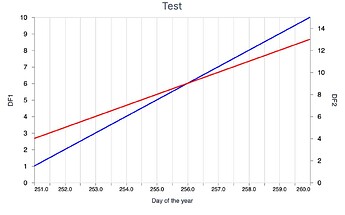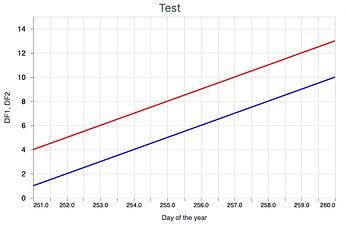I am searching for version to plot two dataframes with the same colon name into a layer each. I tried it in VegLite Json:
{
"$schema": "https://vega.github.io/schema/vega-lite/v5.json",
"data": {
"values": [
{"x": 1, "y": 10},
{"x": 2, "y": 20},
{"x": 3, "y": 15}
],
"name": "data1"
},
"layer": [
{
"data": {
"values": [
{"x": 2, "y": 30},
{"x": 3, "y": 25},
{"x": 4, "y": 35}
],
"name": "data2"
},
"mark": "line",
"encoding": {
"x": {"field": "x", "type": "quantitative"},
"y": {"field": "y", "type": "quantitative"},
"color": {"value": "blue"}
}
},
{
"data": {"name": "data1"},
"mark": "line",
"transform": [
{"filter": {"field": "x", "range": [2, 3]}}
],
"encoding": {
"x": {"field": "x", "type": "quantitative"},
"y": {"field": "y", "type": "quantitative"},
"color": {"value": "red"}
}
}
],
"resolve": {
"scale": {
"x": "shared",
"y": "independent"
}
}
}
What I came up with in Elixir draws the seconds DataFrame so that, it is WWWWAY to high over the correct place and the y range is evenly wrongly scaled:
def create_compare_graph(data_a, data_b, title, col) do
Vl.new(width: 500, height: 300, title: title)
|> Vl.data_from_values(data_a,
only: ["day", col])
|> Vl.layers([
Vl.new()
|> Vl.mark(:line, color: "blue")
|> Vl.encode_field(:x, "day",
type: :quantitative,
title: "Day of the year"
)
|> Vl.encode_field(:y, col,
type: :quantitative,
scale: [domain: [0, 1]],
title: "DF1"),
Vl.new()
|>Vl.data_from_values(data_b,
only: ["day", col])
|> Vl.mark(:line, color: "red")
|> Vl.encode_field(:x, "day",
type: :quantitative,
title: "Day of the year")
|> Vl.encode_field(:y, party,
type: :quantitative,
scale: [domain: [0, 1]],
title: "DF2")
])
|> Vl.resolve(:scale, y: :independent)
end
end
Example Data:
DF1:
day value
| 250 | 0.125
| 251 | 0.13
| 252 | 0.13
| 256 | 0.14
| 257 | 0.14
DF2:
day value
| 250 | 0.36
| 251 | 0.36
| 252 | 0.36
| 256 | 0.36
| 257 | 0.36
If possible I would prefer to do it, in Tucan as the code locks much cleaner with it. ![]()






















